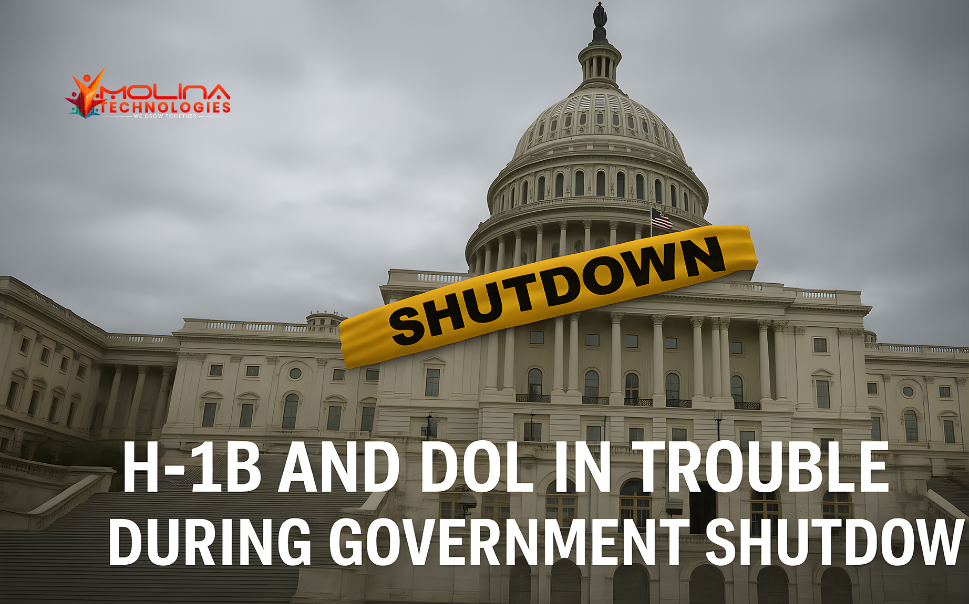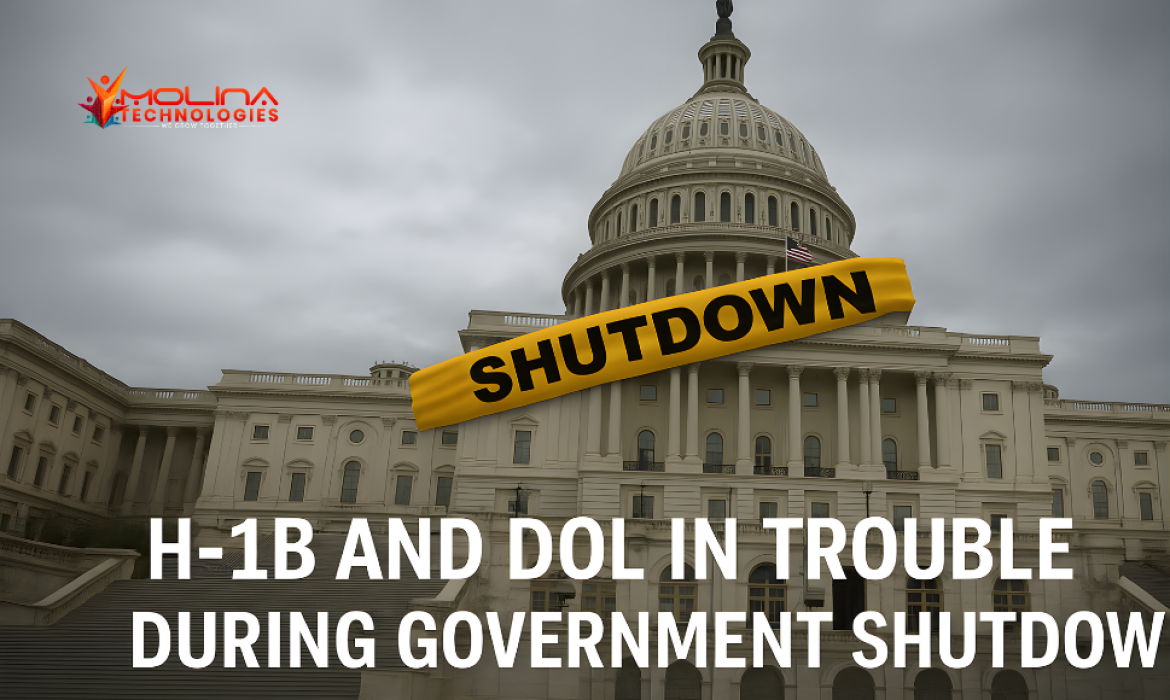
Understanding the US Government Shutdown and Its Immigration Impact
A US Government Shutdown Immigration event occurs when Congress fails to pass funding bills, halting operations across several federal agencies. In 2025, this continues to be a pressing issue for U.S. employers, foreign workers, and immigration attorneys who depend on seamless agency operations to process visas, labor certifications, and work authorizations.
The shutdown doesn’t affect all agencies equally — some are fee-funded and continue operating, while others rely solely on congressional appropriations, forcing them to suspend critical services. This distinction determines whether your H-1B, PERM, or visa application moves forward or freezes entirely.
What Triggers a US Government Shutdown?
A shutdown begins when Congress and the President fail to agree on a budget or stopgap measure known as a Continuing Resolution (CR). Without that funding, agencies not deemed “essential” are required by law to pause operations.
This funding gap cascades through the immigration system — freezing some functions while leaving others largely unaffected. Understanding which departments are affected helps employers plan filings and employees protect their legal status.
How Immigration Agencies Are Funded
- Fee-Funded Agencies like USCIS and DOS continue most services because they operate on application fees.
- Appropriated Agencies such as the Department of Labor (DOL) halt operations since their budgets depend on congressional appropriations.
This structural split is the core reason immigration is partially functional during a shutdown.
Department of Labor (DOL) and Immigration Processing Delays
Among all agencies, the Department of Labor’s Office of Foreign Labor Certification (OFLC) experiences the most significant disruption. Because it’s funded almost entirely through appropriations, its systems and staff are frozen until Congress restores funding.
Labor Condition Applications (LCAs) Stop Completely
The first domino to fall is the Labor Condition Application (Form ETA-9035/9035E). Employers must file an approved LCA before submitting an H-1B petition to USCIS. When the DOL is closed, no new LCAs can be processed, blocking the submission of new or amended H-1B filings.
Employers should:
- File LCAs before a potential shutdown.
- Use previously certified LCAs for permissible transfers or extensions.
- Keep evidence of attempts to file for future USCIS leniency.
🔗 Official DOL Resource: U.S. Department of Labor – H-1B Program
Prevailing Wage and PERM Process Suspension
Similarly, all Prevailing Wage Determinations (PWDs) and PERM Labor Certification processes freeze during a shutdown. For companies sponsoring foreign nationals for permanent residency, this halt can delay green card timelines by months.
Employers are encouraged to track deadlines and prepare case documentation so filings can resume immediately when systems reopen.
USCIS Status: What Continues and What Doesn’t
The U.S. Citizenship and Immigration Services (USCIS) continues most of its operations during a government shutdown because it’s fee-funded. However, it still feels indirect effects due to dependencies on other agencies.
Fee-Funded Petitions: Still Operational
Applications such as:
- Form I-129 (H-1B, L-1, O-1)
- Form I-140 (Immigrant Petition for Alien Worker)
- Form I-485 (Adjustment of Status)
remain active. Premium Processing services also typically continue.
🔗 Official USCIS Resource: USCIS – I-129 Petition
When USCIS Rejections May Occur
If a petition relies on documentation from a closed agency — for example, a certified LCA from DOL — USCIS will reject the filing. Therefore, even though USCIS is open, its hands are tied if statutory requirements can’t be met.
E-Verify Shutdown: Compliance Guidance for Employers
The E-Verify system, used to confirm employment eligibility, typically goes offline during a shutdown because it depends on appropriated funding.
Employers must still:
- Complete Form I-9 for new hires.
- Retain documentation showing the E-Verify system was unavailable.
- Create the E-Verify case once the system is back online.
Failure to do so may result in compliance violations, even if unintentional.
🔗 Check Status: E-Verify Home Page
Maintaining Legal Status During the Shutdown
Foreign nationals must maintain lawful presence in the U.S. despite administrative delays.
USCIS “Extraordinary Circumstances” Policy
USCIS may consider a shutdown an “extraordinary circumstance” that excuses late filings for extensions or changes of status — provided the petitioner can prove the shutdown directly caused the delay. Documentation and legal consultation are essential.
Temporary Strategies for Expiring I-94s
Those with expiring I-94 records may file a B-2 change of status as a bridge measure while waiting for DOL systems to reopen. This preserves lawful stay and allows for refiling once certifications resume.
Impact on Other Immigration Agencies
| Agency | Status During Shutdown | Impact Summary |
|---|---|---|
| Department of State (DOS) | Operational (fee-funded) | Visa processing continues but with potential interview delays. |
| Customs and Border Protection (CBP) | Essential Services Continue | Borders remain open, but expect staffing shortages. |
| Immigration and Customs Enforcement (ICE) | Essential Services Continue | Enforcement and detention proceed; administrative audits may pause. |
Employer Strategy Checklist: Preparing for and Managing a Shutdown
Before the Shutdown
- File LCAs, PWDs, and PERM applications early.
- Communicate with counsel about case prioritisation.
- Maintain internal spreadsheets of pending filings.
During the Shutdown
- Document all failed submission attempts.
- Keep employees informed of expected delays.
- Avoid international travel for workers awaiting filings.
After the Shutdown
- Re-file immediately once systems reopen.
- Monitor FLAG system updates for queue restoration.
- Expect delays due to backlog — prioritize time-sensitive cases.
Official Government Links and Resources
| Topic | Official Source | Direct Link |
|---|---|---|
| H-1B Petitions (I-129) | U.S. Citizenship and Immigration Services | uscis.gov/i-129 |
| DOL H-1B Program | U.S. Department of Labor | dol.gov/h1b |
| E-Verify System Status | Department of Homeland Security |
Conclusion: Strategic Compliance for a Resilient Immigration Plan
A US Government Shutdown Immigration event can bring operations to a standstill, but proactive planning makes all the difference. Employers who act early — by pre-filing, maintaining meticulous records, and staying informed — can minimize risk and delay.
For foreign nationals, legal consultation and status management remain critical. Staying compliant today ensures an uninterrupted status tomorrow.
Disclaimer: This blog post is for general informational purposes only and does not constitute legal advice. Immigration law is highly complex and subject to change, especially during periods of government transition. While we aim to provide you with knowledge to MOLINA TECHNOLOGIES contact for your career success and navigate these processes, all readers should consult with a qualified, licensed immigration attorney for advice specific to their situation.
Frequently Asked Questions (FAQs)
No. USCIS remains open since it operates primarily on application fees.
No. You need a certified LCA from DOL before USCIS can accept your petition.
E-Verify goes offline, but employers must still complete Form I-9 and create cases later.
Yes. Both are suspended until the DOL resumes operations.
Keep thorough documentation, consult counsel, and track cases for immediate refiling once systems reopen.
Consult an immigration attorney about bridge filings like B-2 status to maintain lawful presence.

